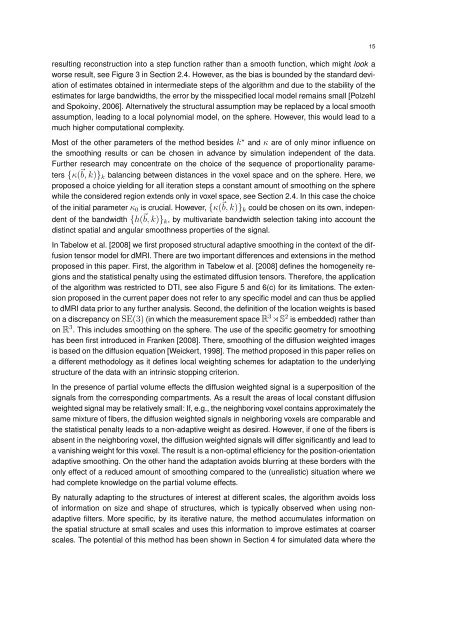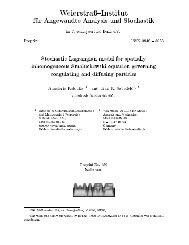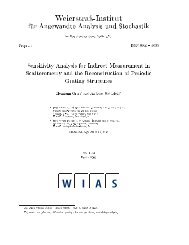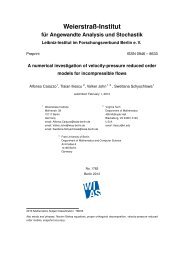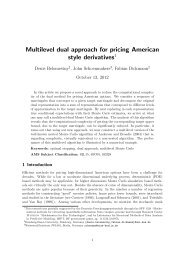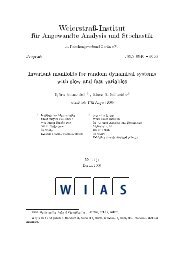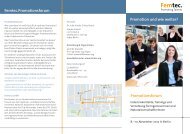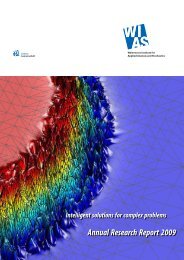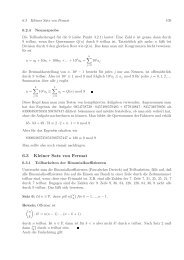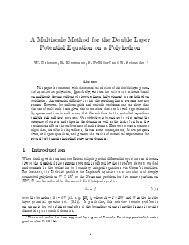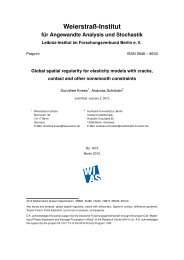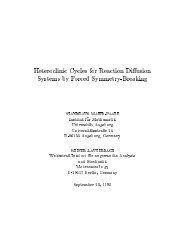PDF (5143 kByte) - WIAS
PDF (5143 kByte) - WIAS
PDF (5143 kByte) - WIAS
You also want an ePaper? Increase the reach of your titles
YUMPU automatically turns print PDFs into web optimized ePapers that Google loves.
esulting reconstruction into a step function rather than a smooth function, which might look a<br />
worse result, see Figure 3 in Section 2.4. However, as the bias is bounded by the standard deviation<br />
of estimates obtained in intermediate steps of the algorithm and due to the stability of the<br />
estimates for large bandwidths, the error by the misspecified local model remains small [Polzehl<br />
and Spokoiny, 2006]. Alternatively the structural assumption may be replaced by a local smooth<br />
assumption, leading to a local polynomial model, on the sphere. However, this would lead to a<br />
much higher computational complexity.<br />
Most of the other parameters of the method besides k ⋆ and κ are of only minor influence on<br />
the smoothing results or can be chosen in advance by simulation independent of the data.<br />
Further research may concentrate on the choice of the sequence of proportionality parame-<br />
ters {κ( b, k)}k balancing between distances in the voxel space and on the sphere. Here, we<br />
proposed a choice yielding for all iteration steps a constant amount of smoothing on the sphere<br />
while the considered region extends only in voxel space, see Section 2.4. In this case the choice<br />
of the initial parameter κ0 is crucial. However, {κ( b, k)}k could be chosen on its own, indepen-<br />
dent of the bandwidth {h( b, k)}k, by multivariate bandwidth selection taking into account the<br />
distinct spatial and angular smoothness properties of the signal.<br />
In Tabelow et al. [2008] we first proposed structural adaptive smoothing in the context of the diffusion<br />
tensor model for dMRI. There are two important differences and extensions in the method<br />
proposed in this paper. First, the algorithm in Tabelow et al. [2008] defines the homogeneity regions<br />
and the statistical penalty using the estimated diffusion tensors. Therefore, the application<br />
of the algorithm was restricted to DTI, see also Figure 5 and 6(c) for its limitations. The extension<br />
proposed in the current paper does not refer to any specific model and can thus be applied<br />
to dMRI data prior to any further analysis. Second, the definition of the location weights is based<br />
on a discrepancy on SE(3) (in which the measurement space R 3 ⋊S 2 is embedded) rather than<br />
on R 3 . This includes smoothing on the sphere. The use of the specific geometry for smoothing<br />
has been first introduced in Franken [2008]. There, smoothing of the diffusion weighted images<br />
is based on the diffusion equation [Weickert, 1998]. The method proposed in this paper relies on<br />
a different methodology as it defines local weighting schemes for adaptation to the underlying<br />
structure of the data with an intrinsic stopping criterion.<br />
In the presence of partial volume effects the diffusion weighted signal is a superposition of the<br />
signals from the corresponding compartments. As a result the areas of local constant diffusion<br />
weighted signal may be relatively small: If, e.g., the neighboring voxel contains approximately the<br />
same mixture of fibers, the diffusion weighted signals in neighboring voxels are comparable and<br />
the statistical penalty leads to a non-adaptive weight as desired. However, if one of the fibers is<br />
absent in the neighboring voxel, the diffusion weighted signals will differ significantly and lead to<br />
a vanishing weight for this voxel. The result is a non-optimal efficiency for the position-orientation<br />
adaptive smoothing. On the other hand the adaptation avoids blurring at these borders with the<br />
only effect of a reduced amount of smoothing compared to the (unrealistic) situation where we<br />
had complete knowledge on the partial volume effects.<br />
By naturally adapting to the structures of interest at different scales, the algorithm avoids loss<br />
of information on size and shape of structures, which is typically observed when using nonadaptive<br />
filters. More specific, by its iterative nature, the method accumulates information on<br />
the spatial structure at small scales and uses this information to improve estimates at coarser<br />
scales. The potential of this method has been shown in Section 4 for simulated data where the<br />
15


